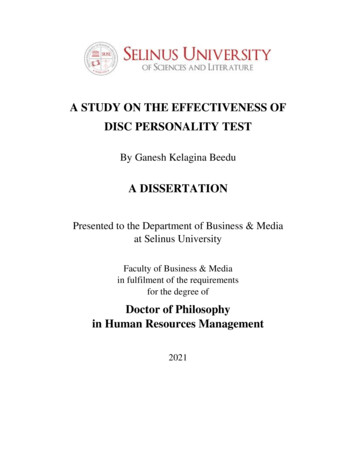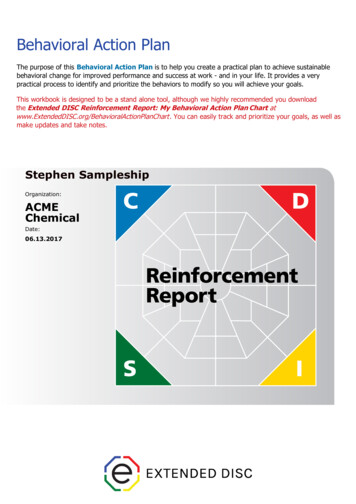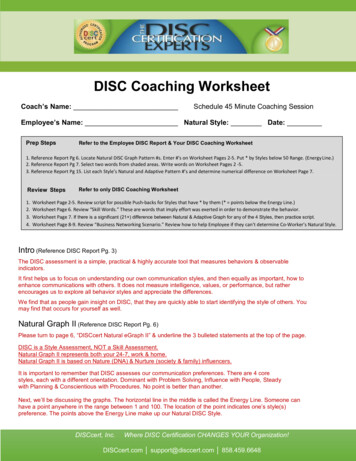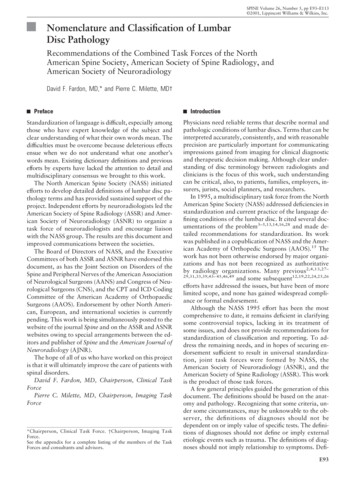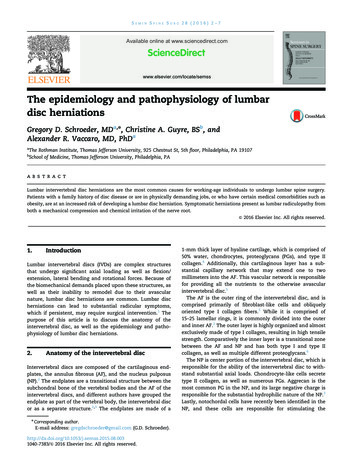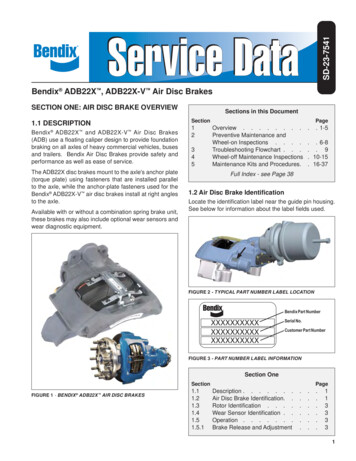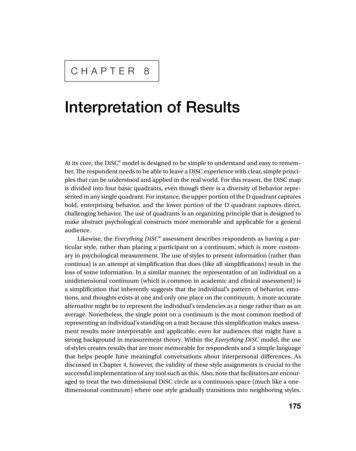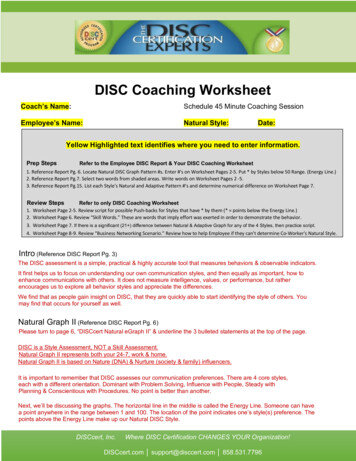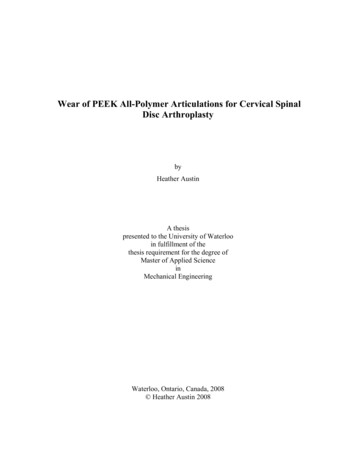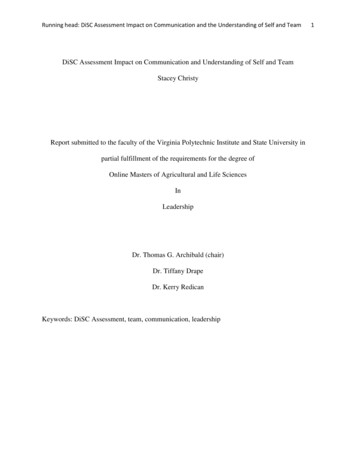
Transcription
Running head: DiSC Assessment Impact on Communication and the Understanding of Self and TeamDiSC Assessment Impact on Communication and Understanding of Self and TeamStacey ChristyReport submitted to the faculty of the Virginia Polytechnic Institute and State University inpartial fulfillment of the requirements for the degree ofOnline Masters of Agricultural and Life SciencesInLeadershipDr. Thomas G. Archibald (chair)Dr. Tiffany DrapeDr. Kerry RedicanKeywords: DiSC Assessment, team, communication, leadership1
DiSC Assessment Impact on Communication and the Understanding of Self and Team2AbstractIn athletics, as in other group activities, teamwork and leadership are highly important concepts.The purpose of this project is to use the DiSC personality assessment to help promote selfreflection and improved teamwork among the members of a collegiate volleyball team. A groupof participants was selected to explore if team attitudes and behaviors can be impacted by takingand implementing the DiSC assessment. Originating with William Moulton Marston, the DiSCwas then turned into an assessment by Walter Vernon Clarke. The volleyball team was given apre and post survey to assess if there were changes in their understanding of themselves as wellas their teammates based on their reflections on their various DiSC scores. The team was givenfour interventions following taking the pre survey and prior to taking the post survey. In theinterventions the players were split up by their style group (as identified via their DiSC scores)originally in four groups to learn more about themselves then for the remainder in pairs withsomeone of a differing style so they could have the opportunity to learn the minds and leadershiptactics of those with a style other than their own through differing activities. The activitiesallowed the players to discover each other’s motivators, strengths and weaknesses for themselvesand when working with others, as well as what they are going to do differently whencommunicating with people in each style so that the communication is as effective as possible.Pre and post survey results revealed the importance the participants saw in participating as wellas the knowledge and understanding the got about themselves and the other three stylesthroughout the process.
DiSC Assessment Impact on Communication and the Understanding of Self and Team3Table of ContentsBackground . 4Introduction . 6Methodology and Design . 14Results . 18Conclusion . 21References . 23
DiSC Assessment Impact on Communication and the Understanding of Self and Team4BackgroundLeadership is a part of every team no matter the size or common goal. It is crucial tounderstand that there is never just one leader in a team and that having shared leadership fromdiffering individuals gives the team a better-rounded, diverse and dynamic approach (Jowett &Chaundy 2004). In order to be an effective leader and member of a team you must know how tocommunicate on a personal and individualized level with each team member. A team is only asstrong as its weakest link so if there are individuals on the team that do not know how topersonalize and individualize their communication with each member it can becounterproductive in moments that require quick communication and can lead to an unsuccessfuloutcome as the result.Every team needs continued evaluation and reflection especially with increased change inmembership within the team. As membership to the team changes so does the dynamic andculture of the team with each instance of turn over and add in. There are many assessments usedto help people become more aware of themselves as well as those around them. In many certifiedand qualified in the world of executive coaching in the world of assessments discuss thedifferences between ones such as strength finder, DiSC, Myers-Briggs Type Indicator, EmotionalIntelligence and 360. Some were quoted saying the DiSC assessment offers “a chance to seefrom an objective, non-judgmental way about what’s true about me and different from someoneelse” (Malik, 2009). This relatively unbiased yet informative aspect of the DiSC assessment ispart of the reason it was the best assessment for this study. Another being that with thisassessment it provides you the information with how to connect and relate to people that havecontrasting behaviors from themselves. In the society we live in today, people have a skewedperception of themselves and how they feel they must compare themselves to others. This
DiSC Assessment Impact on Communication and the Understanding of Self and Team5assessment allows them to recognize these differences instead of compare, which is especiallykey with females, as well as recognize they aren’t alone and that there are many other out therewith very similar behaviors as their own allowing them a sense of belonging. This recognitionhelps them see the diversity that is all around them and get to know each level of diversity on adeeper level. This assessment is unique in that it provided participants “easy-to-rememberguidance on how to most effectively communicate with each style” put best as helping you “treateveryone the way they want to be treated” (Sebastian, 2009). The simplicity of using thisassessment makes it easy to be able to recognize the styles of co-workers, peers, teammates andleaders.The DiSC, created in 1956 after adapting William Marston’s book (discussed later), goesinto the many levels, dynamics, needs and challenges teams can face due to their differing styles.It is based around the five behaviors of a cohesive team, which are trust, conflict, commitment,accountability, and results. (Bullwinkle, 2016). The main objectives the DiSC has been used for,even by fortune 500 companies, are to improve communication, reduce workplace conflict,increase acceptance of diverse behaviors, improve productivity, improve team spirit and improveteam effectiveness. Most importantly as we already discussed to explore these behaviors in a safenon-judgmental manner (Sebastian, 2009). These show that this assessment is going to be able tohelp this team grow in order to help them help themselves reach the level of individualunderstanding necessary to meet their shared goals. This is an assessment that has been used withcoaches before and was seen to be valued by the players due to the fact that it allowed theplayers to explore their strengths, which provided clear expectations from their coaches, it alsoletting the players see the impact these strengths play on their lives and the affect they have ontheir values and how both work collaboratively in their daily life (Parsons, 2016).
DiSC Assessment Impact on Communication and the Understanding of Self and Team6Athletic teams go through all of these behaviors on a more public platform and can beassessed for their successes in a more black and white manner. Within athletics, there is a varietyof differing team dynamics due to the type of sport. For this study choosing a track and fieldteam would be counterproductive to the goals of this study since it is based largely on individualperformance. Sports such as basketball and volleyball would be best for this initial study due tothe smaller team sizes, the short duration in which they have to share information withteammates and coaches as well as the ability to work one on one with members during theintervention process. For this study it allows each player to have easy access to each teammate,the need for quick effective communication and the opportunity to grow and retain all the newfound information about oneself and their teammates.IntroductionAthletic teams pride themselves on creating a culture that inspires leadership, and thatvalues good communication and working effectively together to reach a common goal. In orderto reach the necessary communication level, knowing each individual players’ leadership andcommunication styles is key. This study focuses on pairing individuals with different leadershipstyles together in order to diversify their knowledge of leadership. In the past many havebelieved that you must treat each player equally to create an idea of fairness. However, I proposethat in order to truly be fair you must recognize the individuality of each person and that the fairthing to do is interact with them in a way that resonates best with them.In this study the participants engaged in an initial assessment called the DiSC assessment.This assessment stems from the DiSC theory of psychology created by William Marston in hisbook published in 1928 “Emotions of Normal People”(DiSC profile, 2008). He developed it with
DiSC Assessment Impact on Communication and the Understanding of Self and Team7the idea that each person’s perception of their self was related to their environment and could beplaced into four categories: Dominance, Inducement, Submission and Compliance. This idea hascome a long way in the decades that have followed and was then turned into the personality testit is today, though the current model has shifted the four styles slightly and made themDominance, Influence, Steadiness and Conscientiousness (DiSC Profile, 2010. These styles canbe defined as follows Dominance (D): “Person places emphasis on accomplishing results, thebottom line, confidence”, Influence (I): “Person places emphasis on influencing or persuadingothers, openness, relationships”, Steadiness (S): “Person places emphasis on cooperation,sincerity, dependability and Conscientiousness” (C): “Person places emphasis on Quality andaccuracy, expertise, competency” (DiSC Profile, 2010). Upon completion of the test the resultsgive a score for each of the four styles. The scale intensity for each of the 4 goes up to 28. S forexample someone could score D 12, I 4, S -9 and C -6; this makes them part higher inDominance than all the other 4 areas and will provide them with a graph similar to one of theones in Figure 1. The main style is based on the tendencies of the participant’s behaviorsaligning with the behaviors of that style set. Each of the four styles has subgroups that help themlearn more about their behavior styles when to take into consideration the results of the otherthree scores. In this study, the other three scores are only being taken into consideration if thereisn’t a diverse amount of styles to pair people off with their opposite styles or someone with adiffering main behavior style.
DiSC Assessment Impact on Communication and the Understanding of Self and Team8Figure 1. Example of personality profile patterns using the DiSC assessment. Adapted fromDhawan (2015).These scores provide which style your personality is most like, but as discussed earlieralso provides more specifics by respecting the scores in the other three styles. The benefits ofthis test is that it’s specific to coaching, communication, teambuilding, conflict management, andleadership development (DiSC Profile, 2010). Though this assessment isn’t able to measureevery aspect of your personality this assessment looks at how you respond to challenges,influence others, respond to rules and your preferred pace in activity. Having this knowledgeabout the individuals on the team will be allow their teammates to have a better understanding oftheir motivators, demotivators, fears, possible weaknesses, communication styles, expectation ofothers, possible conflict triggers, general traits, strengths and capability with individuals of eachstyle (Sebastian, 2009). After taking the assessment the team members will be able to reducefuture conflict, avoid miscommunications, understand how those work who aren’t like you,improves team member and team communication as well as enabling team building. The benefits
DiSC Assessment Impact on Communication and the Understanding of Self and Team9and outcomes from using this assessment are heightened when used on teams going throughchange and results can be seen more predominantly since they are already working on improvingthemselves. For these purposes the Virginia Tech Volleyball Team are the participants used forthis study. This team got a whole new coaching staff as of spring 2017. This is a team that canbenefit the most from this study and provide us with the most honest feedback since they haven’tdeveloped deep loyalties to the coaching staff yet and will be less afraid to share their unbiasedtrue feelings anonymously.When it comes to athletes, and many other forms of teams they are short on time, theDiSC being a quick and easy assessment to conduct allows for a time saving yet effective way tohelp the team succeed. This assessment allows the person taking it to know their strengthsconcretely and in a nonjudgmental manner. The results of this assessment tell the taker where therank in all one areas with giving hierarchy to one area. The area the person ranks highest in tellsthe most about their behavior traits and their common thought processes. Not all traits matcheach person within the category, but a majority will. Using the scores from the other three areasallows one to get more in depth descriptions of their personality, but for this study we will beingusing the area they rank highest in, in order to let them learn the most about their oppositebehavior style. The objectives of this project are to:1.Help participants increase their understanding of how others behave, especially peoplewho have the opposite behavioral styles from their own by the end of the study;2.Increase communication on and off the court among participants;3.Evaluate if the player feels interactive leadership and knowledge of their teammates willincrease their shared level of success by the end of this study and moving forward
DiSC Assessment Impact on Communication and the Understanding of Self and Team10Review of LiteratureThe purpose of this study is so that people who are part of team teams are able to take inthe benefits that come with knowing their own personal self and style and how this can lead toworking more “collaboratively, knowing what styles they may be able to work most efficientlywith and the styles where interactions may take more mindfulness” (Morgan, 2017). Each personthinks and processes things in their own way, which is what makes us unique. When it comes toathletes this is no different, though some would assume otherwise when comparing people of thesame gender, competing in the same sport on the same team. Many studies have been done oncommunication and how this relates to team performance. Duarte, Araujo & Davids (2012)stepped outside of the norm that looked into just one aspect of performance such as defense andlooked at how the interactions of the whole team impacted performance. The outcome of apractice, workout or game all comes down to how the group works together.A study done to help teamwork with doctors and all supporting staff in the OR found thatteam training, such as the interventions done with the participants of this study, improvedperformance and found continued training (interventions) would create sustained improvementand/ or culture (Forse, 2011). Though this study doesn’t have the sustainability suggested byForse it does include the need for knowledge of one another in a training atmosphere with theintention to improve team functionality when it really mattered, in their case in the OR and inthis study when they’re in games.Beauchamp, Maclachlan & Lothian (2005) conducted a study using a sports psychologyin a parallel form to how this study was conducted, but using the Jungian assessment. Thepsychologist had each individual complete the assessment, discuss their results and theirmeaning, ensure all participants know that no result is bad or less than another’s results, how
DiSC Assessment Impact on Communication and the Understanding of Self and Team11their preferences might impact team functionality and potential blind spots for their type. It iscrucial to begin any study that includes an assessment with awareness not just of their ownresults, but the results of their peers and how they compare and contrast with their own because“in order to effectively ‘adapt and connect’ with other team members, one must first develop andacute understanding of self as well as the patterns of preferences that characterize those withwhom one interacts” (Beauchamp, Maclachlan & Lothian, 2005, p. 212).The participants were then ready for “group-level” interventions in which they couldassign characteristics to each type through “educational workshops”. The result of this individualand group knowledge through intervention and workshops was that they were now able to usetheir contrasting types as a unite to make the team better through knowledge of “(a) their ownand others’ communications styles, (b) potential barriers to effective communication, (c) theirown (and the team’s) possible blind spots, as well as (d) strategies for personal and collective(i.e. team) development” (Beauchamp, Maclachlan & Lothian, 2005, p. 211-212). Acquiring thisdepth of knowledge about each individual on their team can help them recognize reasoningbehind certain characteristics and develop an understanding for their teammate as a person “thiscan enable them to more effectively adapt their communication behaviors to successfully‘connect’ with each other” (Beauchamp, Maclachlan & Lothian, 2005, p. 212). The outcome ofthese two previous studies are solidification as to the benefits the team would gather from notonly taking the assessment, but including the addition of intervention process.The assessment itself has proved to be appropriate for the target group given their limitedtime with a strenuous schedule. The “DiSC assessment is quicker and less taxing because it isonly around 25 questions allowing for a more flexible assessment to better meet the needs ofusers on a customizable level” (Bales, 2015). With this being said it doesn’t lack accuracy as it
DiSC Assessment Impact on Communication and the Understanding of Self and Team12has been an assessment to last through the decades and has had continuous use not just in sports,but in many workplace environments, books around the world in 35 languages and taken bymore than 50 million people (Jones & Hartley 2013). The DiSC assessment has found theiraccuracy ratings to be 91% for style D, 94% for style I, 85% for style S and 82% for style C(Jones & Hartley 2013). The reasoning for the lower accuracy for the S and C styles could bedue to decreased assessment takers being in the S and C style groups. Even so the accuracy isstill high enough that the assessment is able to help participants “learn how they tend to react incertain situations at work” (Bales, 2015), which with the proper knowledge and tools cancommunicate these tendencies to co-workers and teammates for increased interactivecommunication and understanding. The benefits of using this 4 factor assessment compared to afive factor assessment were found to be that it proven reliable and consistent, provides a wellrounded personality view (personal, private, public), and have been shown to be a predictor ofsuccess in areas such as employee retention and job success.Another study that helped aid in the development of this one was done on NCAA femalegolfers by Williams (1991) using a questionnaire and their end of season’s performances to testcohesion. They found that cohesion significantly predicted performance outcome,communication, and motivation as assessed by commitment to the team goal. The use of aquestionnaire aided in seeing where the athletes felt their levels of cohesion where and enabledthese results to be studied in comparison to their results. Using a survey at the beginning and endof a study allows to see if the athletes’ feelings and understanding have changes especially in astudy that provides intervention and is not based on observations such as Williams’s.The requirements for the intervention were based on the necessities of how to maximizethe effects of the DiSC. Rosenberg & Silert (2012) recognize that there are ways you can build
DiSC Assessment Impact on Communication and the Understanding of Self and Team13relationship with friends, family, teammates, co-workers, etc, not by just knowing but applyingwhat you know. The ways they suggest doing this is finding someone (this study chose oppositeor differing style partners to conduct something similar) and seeing how you can apply yourstrengths to that person, what styles they need to exhibit more and less of in order to improve therelationship with them and others in the style, the adversity they are likely to encounter with thisperson/ style and lastly what they’re going to do in order to overcome these barriers. This studygoes into each of these aspects in depth in each of the 4 interventions so they can have thenecessary time commitment and discussion to fully understand themselves and other styleswithout being rushing into another discussion area.The effectiveness and necessity for this study increases with the team having newcoaching staff. They are in-between cultures and in order to help built that culture up having adeeper understanding of their teammates on and off the court allows for better cohesion as wellas working as a unite with little push back to have the drive and motivation to embrace the newculture and staff. Having this knowledge of themselves and other will allow them the opportunityto express to the new staff the best ways to communicate and drive them as well as suggest moreeffective avenues in which the staff can communicate with their teammates and the group as awhole. Though it’s important to recognize that results of team cohesion could be skewed due tohow they view their relationship with their coach is they two work in unison (Jowett & Chaundy,2004). Athlete- Coach Relationships and team cohesion is shown in a study by Jowett &Chaundy (2004) to have positive and increased attitudes when they feel they sharecommonalities (p. 309). Without these commonalities they feel they lack the communicationand are too dissimilar to create a meaningful interpersonal communication. With lack of theknowledge for commonalities and connections, that DiSC can provide, it makes sense why
DiSC Assessment Impact on Communication and the Understanding of Self and Team14Jowett & Chaundy (2004) found that teams with dissimilarities had evidence of personal conflict,cliques and disconnection (p. 309). DiSC allows participants to see how they are different yet atthe same time similar since yes they might have different styles of can see similarities presentedby how their remaining scores for the other style areas impact their behavior and make themmore alike. The DiSC also provides avenues to know how to connect and build thoserelationships with those of differing styles because they know with a little education thisdiversity can prove to be a huge asset for the team or group at hand.Methodology and DesignThis study was a mixed methods study. The project initiates with the members of theSpring 2018 Women’s Volleyball team taking the pre-survey, shown in Table 1, to get a base ofwhat their communication and understanding between different behavioral styles is like on theteam. They were provided the instructions of “This survey is being conducted in order to getindividual perspectives of leadership and communication on a team. This survey will take 5minutes to complete and your responses will be confidential.”The team’s roster usually carries 18 members, but due to seniors completion of eligibilitythe Spring Roster only held 10 members, one of which was not part of this study due to extensiveconcussion problems. Following the survey they took the DiSC assessment. Only team memberstook the assessments, attend focus groups and complete surveys; coaching staff did not. Once theindividual results of the assessment were evaluated, the players were paired off with people inopposite styles than their own. The D leaders have an opposite style from the C and I leadershave an opposite style from the S so they were paired accordingly. Towards the end of pairingdue to an unequal distribution is styles, it was not possible to get a true opposite so some
DiSC Assessment Impact on Communication and the Understanding of Self and Team15individuals were matched with someone with one of the other styles from their own, if necessarymatches can be based on their second highest ranking style and so on until all had a challengingpair, but that was not necessary for this study.The Virginia Tech Student Athlete Development Department had already been told thebenefits of the DiSC assessment on athletes especially tea athletes. The Virginia Tech Volleyballteams was one of the first teams to go through the process of taking the DiSC assessmentthrough the athletic department. Each participant had taken the assessment three months prior tothe start of this studies interventions, though they didn’t know at the time the interventions wouldbe conducted. There results were shared with this study through the results gained by the athleticdepartment with the permission of each participant. Five were assessed as being D’s, two testedas I’s, one as a S and 2 as C’s. When it comes to sports having a high rate of D results due totheir traits of being motivated by winning, success, competition, their forcefulness andwillingness to take risks all of which you would see in a collegiate athlete. For this project and itsintervention purposes the team members were requested to meet for interventions on fourseparate occasions for 20 minutes each to allow thought provoking conversation about their ownas well as the other styles. Each day was planned out with the key concepts from the DiSCassessment in mind as well as the concept of time due to the player’s busy schedules.Intervention 1:Since the team had already taken the DiSC assessment they began the first session by taking thepre-survey individually. The girls were then split up into four groups representing the four styles.Each group was asked to reflect on what they remembered about their style, then received apaper that gave them the same write up about their personality style that they received aftertaking their results following completion of the assessment. The activity for the first day was the
DiSC Assessment Impact on Communication and the Understanding of Self and Team16groups to agree on three strengths they had when interacting with others and three weakness theirstyle had when interacting with others. They then came together as a team and each of the fourgroups shared their responses as well as reiterating the characteristics of their style to the othergroups. Each person then wrote the three weaknesses and three strengths down on a poster board,shown in Image 1 that would be used to collect all their findings after each intervention. Somepeople wrote another team members name in order to save time with writing the all out sincethey had the same answers for this activity, which is the reasoning for more than just the namecolumn being blacked out.Intervention 2:During the second meeting the players were then paired off as illustrated previously, D-C and IS, though there were two D’s that had to be paired off with a D. The pairs were then instructed todiscuss their motivators/training insights and how these impacted how they lead on the court andoff the court. They were also asked to share one way they take in other team members andcoach’s leadership due to their style. They then came together as a team stating one at a timetheir partner’s style, their partner’s motivators and how accept leadership. They then wrote theirpartners responses down on the piece of paper.Intervention: 3The third meeting begins with each of the partners pairing of and reminding their partner of theirmotivators and ability to take in others leadership. For the activity they are then asked to decideon 3 ways they can flex, adapt/ adjust, themselves to motivate someone with their partner’s style(or a style other than their own). The group then came together and shared again their personalstyle, their partner’s style and how they would flex themselves to motivate someone with thatstyle. They concluded by adding these notes to the poster board.
DiSC Assessment Impact on Communication and the Understanding of Self and Team17Intervention 4:The fourth and final meeting had the player’s pair off one last time to decide how they would usetheir new found knowledge of themselves and others styles help improve their leadership. Theythen had to decide on a way of how they would apply this while being apart for summer vacationbefore returning to jump right into training for the start of their competitive training. They thencame together as a group shared their responses and final thoughts from the final activity. Eachpair added their final responses to the poster board to complete the last column of the board. Thislist is then hung up in their locker and will remain the rest of the semester, summer and into theircompetitive season this fall. To conclude the final intervention the players split up individually tocomplete the post
Running head: DiSC Assessment Impact on Communication and the Understanding of Self and Team 1 DiSC Assessment Impact on Communication and Understanding of Self and Team Stacey Christy Report submitted to the faculty of the Virginia Polytechnic Institute and State University in partial fulfillment of the requirements for the degree of
